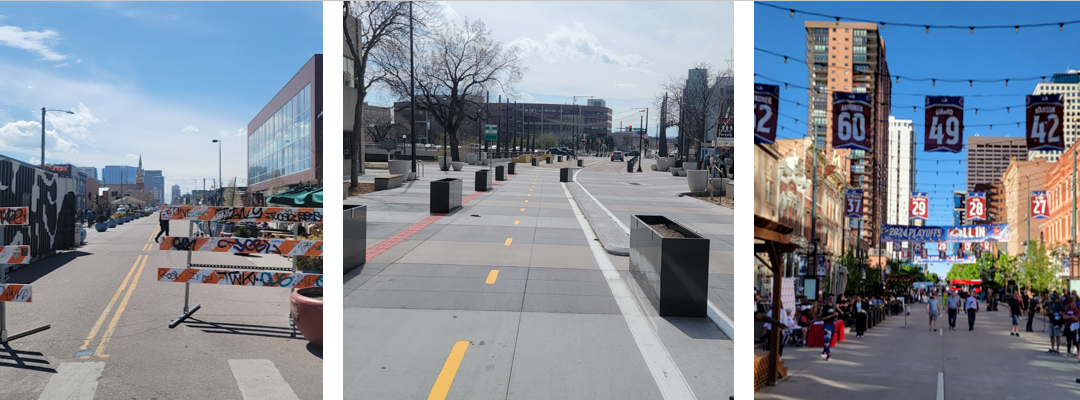We’re excited to share the efforts of local advocates and community members who want to make Denver’s streets better for people. This is a guest post from our friend Justin Bai at Pedestrian Dignity, about how the City of Denver can meet the moment by prioritizing people-centered design changes to Larimer Street in its $500 million expansion of the Downtown Denver Authority announced in May.
By Justin Bai
There is a simple joy in street fairs, parades, and pedestrian malls. It is the joy of having the streets as a space for living, not driving. What if it were possible to reclaim some of that joy permanently in Denver’s downtown? The Livable Larimer campaign seeks to do just that, by making Larimer Street pedestrianized or “car-lite.”
As part of Denver’s original diagonal grid system, Larimer Street cuts through several neighborhoods, from Auraria on the west end, through downtown, to the River North Arts District. It is a vibrant street with retail, restaurants, nightlife, bars, apartments, and more. It also has the potential to be an active, people-centered corridor.
There has already been movement to make parts of Larimer Street for people. The original 2007 Downtown Area Plan identified Larimer Street as the site of a transit-way, where buses could travel separately from other types of traffic. This idea of a transit-way was reiterated in the 2020 DenverMoves: Downtown plan. What these plans could not predict, however, was that there would be a pandemic that would spur interest in opening streets to people. Several developments on Larimer sprung up—Both Larimer Square (between 14th and 15th Streets) and the 2900 block (in the River North Arts District) closed to cars, and the Larimer Street bridge (connecting LoDo to Auraria) was redeveloped to be a pedestrian- and cyclist-oriented space with only one lane for vehicular traffic.

From left to right: 2900 block, Larimer Street bridge, Larimer Square
While these developments make Larimer more friendly for people and active transportation, they also make it less feasible to run a transit-way on this street. However, it’s worth preserving the kernel of the original idea: We should decenter cars on Larimer Street. And we can! It’s just a matter of connecting the dots.
We should decenter cars on Larimer Street. And we can! It’s just a matter of connecting the dots.
The Livable Larimer campaign proposes using three different approaches to de-centering cars—all three of which have successfully transformed parts of Larimer already:
1. Use tactical urbanism and pedestrian-adapted designs to affordably make streets for people. This can involve installing temporary barricades, planters, or patio seating. This is what has been done on the 2900 block.
2. Allow cars to travel while still prioritizing pedestrians and cyclists in a way that discourages high-speed vehicular traffic. An example of this type of design is the woonerf, a Dutch term for “living street,” which typically features a curbless design with planters and other obstacles to slow traffic. This is essentially what has been implemented on the Larimer Street bridge.
3. Establish a pedestrianized design with some degree of permanence. This involves patios and parklets, as well as permanent bollards to prevent vehicular traffic. This is what has been done at Larimer Square.
The time is ripe for this change. Mayor Mike Johnston recently announced plans to expand the Downtown Development Authority, bringing $500 million to the downtown area, where much of Larimer Street resides. Furthermore, Denver is due for its next cycle of general obligation (GO) bonds around 2027, which would provide even more funding for a project like this. And on a practical note, the Downtown Denver Partnership will soon be working on a new Downtown Area Plan.
So let’s make Larimer for living, not just driving.
We at the Denver Streets Partnership see a clear path forward for the downtown area as a safer and more enjoyable public space for people. If you do, too, use our comment guide to let the City know how the Revitalizing Downtown initiative can prioritize pedestrianized streets.

